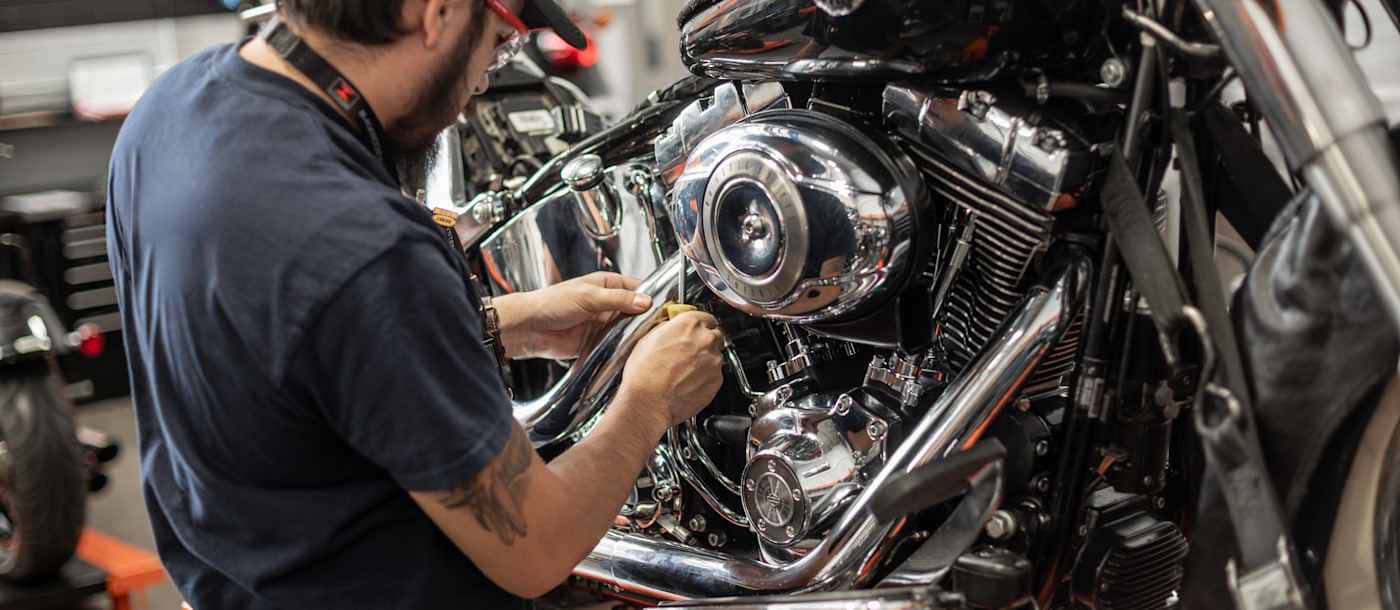Ever wondered how power gets from a motorcycle’s engine to its back wheel?
Understanding motorcycle final drives is key to getting how bikes move, and knowing how to service them is a core skill in motorcycle servicing.
Whether you’re just starting to explore how motorcycles work or thinking about training for a hands-on career, this guide breaks down the different types of drive systems you can come across in the shop.
Let’s take a closer look at how these systems work and how you can learn to work on them.
Chain Drive Systems

How chain drives work
A motorcycle chain drive uses a metal chain and sprockets to connect the engine to the back wheel. As the engine turns, it moves the front sprocket, which drives the chain and spins the rear sprocket. That’s what gets the rear wheel moving.
Advantages
Motorcycle chain drive systems are lightweight and efficient. They also offer flexibility when it comes to gear ratios, which makes them great for performance and racing bikes. Chains are easy to find and replace, and riders can adjust tension as needed.
Common maintenance requirements
Chain systems need regular care. You need to clean and lubricate the chain often to prevent rust and wear. Chain tension also needs checking — too tight or too loose can cause damage. They also eventually wear out and need replacing.
Learn more about what motorcycle technicians do.
Read: 4-Stroke Engines: What Are They and How Do They Work?
Belt Drive Systems
How belt drives work
A motorcycle belt drive uses a reinforced rubber belt instead of a metal chain. It loops between pulleys that do the same job as sprockets, transferring power to the rear wheel.
Advantages
Belts are quieter than chains and need less maintenance. They don’t require lubrication and tend to last longer in normal riding conditions. They’re also smoother to ride and cleaner overall.
Limitations and use cases
Belt systems are not ideal for high-torque setups or off-road conditions. Belts can wear faster under extreme stress or debris-heavy environments. You can mostly see them on cruisers and touring bikes.
Read: Motorcycle Won’t Start? Here’s How to Troubleshoot It
Shaft Drive Systems
How shaft drives work
A shaft drive motorcycle uses a spinning shaft, gears and a differential to send power to the rear wheel. It’s a sealed system, similar to what you’d find in a car.
Advantages
These systems are known for being low maintenance. You don’t need to clean or adjust them like chains or belts. They’re also very durable and great for long-distance riding.
Downsides
Shaft drive motorcycle systems are heavier and pricier to repair. They also absorb more engine power, which can make the ride feel less responsive compared to chains or belts.
Read: Oil and Filter Service for Motorcycles: 3 Most Common Mistakes
Comparing Final Drive Systems
Performance and efficiency
When it comes to raw performance, motorcycle chain drive systems usually win. They’re the most efficient at transferring power. Belts come next, followed by shafts, which are solid but a bit heavier.
Maintenance and longevity
Chains need the most attention. Belts are a middle ground. Shaft drives need the least maintenance but cost more if something goes wrong.
If you want low effort, shaft might be your best bet. If you want control and flexibility, a chain is the way to go.
Cost and repair
Chains are the cheapest to replace and easiest to fix. Belts cost more but last longer. Shaft drives can be pricey to service since they’re more complex and less DIY-friendly.
Read: Essential Motorcycle Tools Every Technician Should Know
You Can Learn How To Service Motorcycle Drive Systems

Hands-on training across all major drive types18
At Universal Technical Institute (UTI), students train with real motorcycle systems, including motorcycle chain drive, motorcycle belt drive and shaft drive motorcycle setups. You can learn in labs that mirror real-world shops, with tools and parts used by today’s top brands.
Career-ready motorcycle servicing skills1
UTI’s Motorcycle Technician Training program covers everything from diagnostics and repair to rebuilding and inspection. You won’t just read about motorcycle final drives — you can take them apart, fix them and put them back together. This type of hands-on training helps students prepare for entry-level roles across a range of manufacturers after graduation.
Explore more about our career training program and how it can prepare you to work with today’s bikes.
Read: How To Become a Certified Motorcycle Technician: A Step-by-Step Guide
Learn About Motorcycle Final Drives and More!
Ready to learn how to service motorcycles and practice with real tools? Our 48-week motorcycle mechanic program offers the training to help you get there.7 You can get hands-on education with all types of motorcycle final drives and leave with the skills to pursue a career you can be proud of.
Want to speak to someone now? Call to connect with an Admissions Representative at 1-800-834-7308, or enroll today and take the first step toward becoming a motorcycle technician.
Universal Technical Institute of Illinois, Inc. is approved by the Division of Private Business and Vocational Schools of the Illinois Board of Higher Education.

